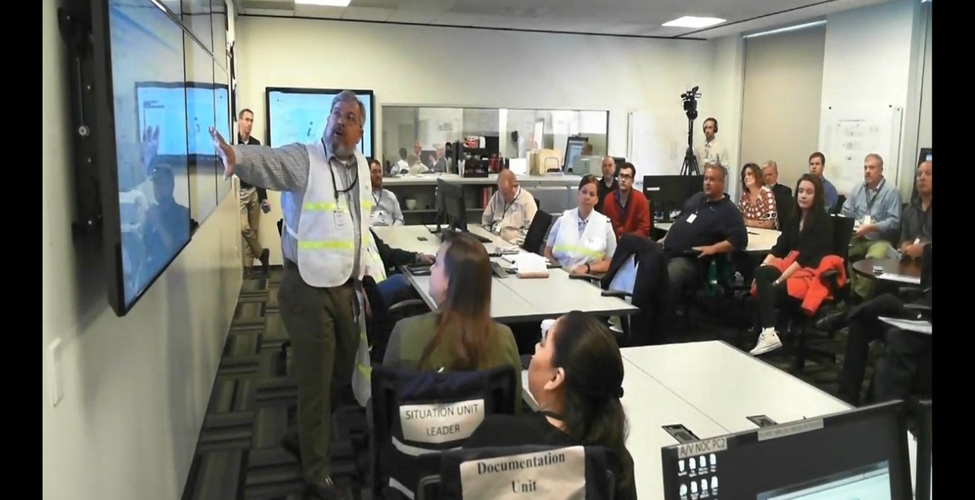NOTE: The USCG published the 2016 PREP Guidelines, which replace the 2002 PREP Guidelines. The 2016 PREP Guidelines became effective on June 10, 2016.
TRIENNIAL EXERCISE OF THE RESPONSE PLAN
Within a three (3) year cycle, all elements of the response plan shall be exercised in a drill, or series of drills, involving the vessel Owner/Operator, the Qualified Individual (QI), Oil Spill Response Organization (OSRO) and Salvage and Marine Fire Fighting (SMFF) resource providers.
To satisfy the requirement of the triennial exercise of the entire response plan, it is not necessary to exercise the entire plan all at one time. The plan may be exercised in segments over a period of three (3) years, as long as each component of the plan is exercised at least once within the three-year period.
The PREP guidelines include fifteen (15) core components that must be exercised to ensure that all plan components function adequately for response to an oil spill. In order to satisfy PREP guidelines, all of the core components should be exercised at a minimum once every three years.
DRILL PROGRAM
It is recommended that a Drill Program in accordance with the PREP Guidelines is followed to maintain satisfactory exercise compliance with the U.S. Coast Guard (USCG) and State of California. A complete and comprehensive drill schedule is a critical part of a thorough training program to exercise the 15 core components of the PREP. Drills provide a forum to exercise the training that has been received, validate the procedures and policies contained in the response plan, and allow for plan modifications when refinements are warranted.
Regular drills, involving ship personnel, will ensure rapid and effective implementation of the Vessel Response Plan (VRP) in the event of an incident. Through a series of Internal and External exercises, drill program, enhances the preparedness of the vessel’s crew, the Spill Management Team (SMT) and the Qualified Individuals (QI).
INTERNAL EXERCISES
Internal exercises are those that are conducted wholly within the plan-holder’s organization. While the internal exercises include personnel such as the QI and those affiliated with the plan holder’s Incident Management Team (IMT), Oil Spill Removal Organizations (OSRO) and/ or Salvage and Marine Firefighting resource providers (SMFF), they do not usually involve other members of the response community. The internal exercises are designed to examine the various components of the response plan to ensure the plan is adequate to meet the needs of the organization for spill response. These exercises can be announced or unannounced and are self-evaluated and self-certified.
The Internal exercises include:
- QI Notification Exercises
- Remote Assessment and Consultation Exercises
- Emergency Procedures Exercises
- Incident Management Team Tabletop Exercises (IMT TTX)
- SMFF Management Tabletop Exercises
- OSRO Equipment Deployment Exercises
- SMFF Equipment Deployment Exercises
- Area exercises; and
- Government Initiated Unannounced Exercises
- Emergency Spill Procedures Exercises
- Emergency SMFF Procedures Exercise
- Response Provider Equipment Deployment Exercises
EXTERNAL EXERCISES
External exercises are exercises that extend beyond the internal focus of the plan holder’s organization, and involves other members of the response community, such as USCG and other government agencies, P&I Clubs, Damage Stability Provider, Salvor, etc. The external exercises are designed to examine the response plan and the plan holder’s ability to coordinate with the response community to conduct an effective response to a pollution incident.
The external exercises include:
While the government-initiated exercises will not usually involve all members of the response community, the involvement of an agency outside of the plan holder’s organization places it in the category of an external exercise.
UNANNOUNCED EXERCISES
Annually, at least one of each of the exercises listed below must be unannounced. An unannounced exercise is one in which the personnel participating in the exercise have not been advised in advance of the exact date, time, or scenario of the exercise.
Periodic unannounced emergency procedure drills are recommended to be conducted by the plan holder to evaluate the readiness of the in-house emergency response team, or the vessel Master in order to evaluate the crew’s preparedness and results of training. Records of such exercises are to be appropriately logged and maintained for a period of no less than three (3) years.
EXERCISE RECORDS
The records of exercises shall be maintained for a period of three (3) years as follows:
| Shipboard Exercises: | Logged on board |
| Shoreside Exercises: | Incident Management Team Offices with a copy sent to Vessel Owner/Operator |
| Unannounced Drills: | Logged onboard and records maintained in the offices of the vessel Owner/Operator and the Qualified Individual |
| Area Exercises: | In the offices of the vessel owner/operator and the Qualified Individual |
| Contracted Resources and Certification Letter: | Maintained in the offices of Oil Spill Removal Organization, Salvage and Marine Firefighting Service Provider(s); and with vessel owner/operator |
| Entire Plan Drill: | In the offices of the vessel owner/operator and the Qualified Individual and SMFF resource provider |



